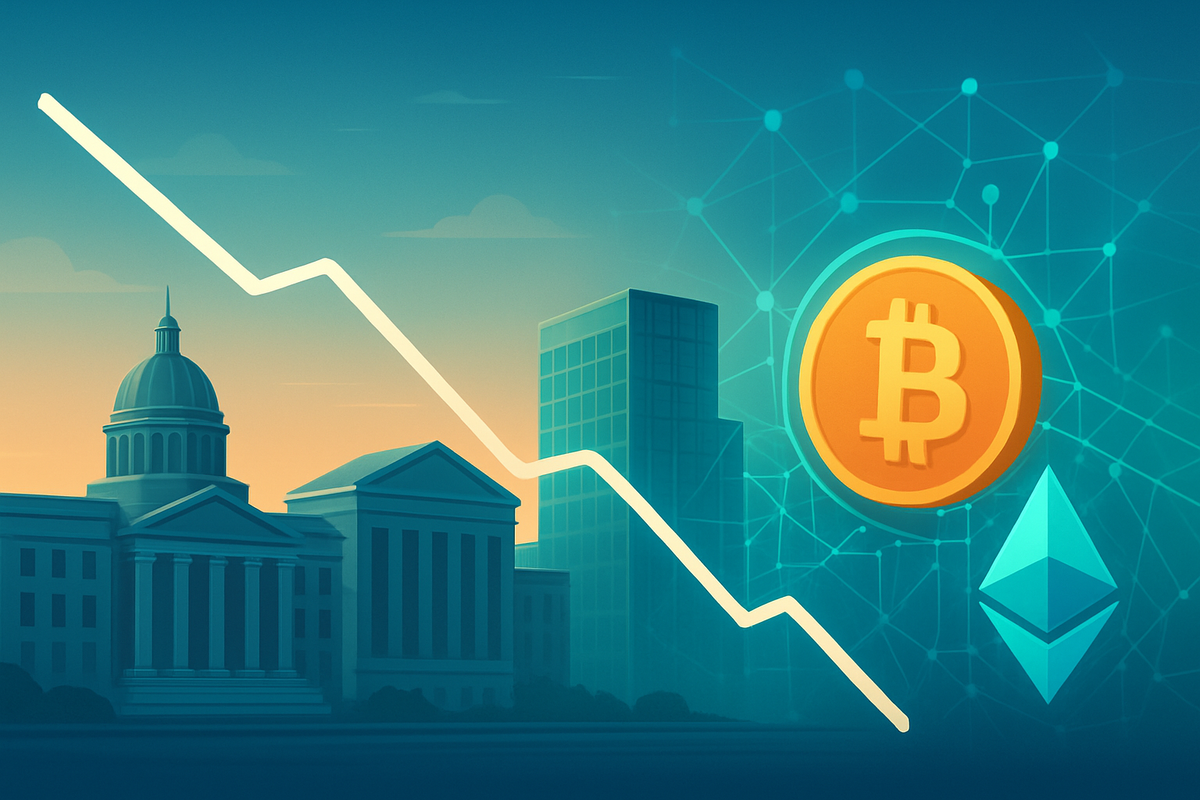
A surprisingly "cooler" U.S. Consumer Price Index (CPI) report, released in November 2025 and reflecting October's data, has sent a wave of optimism through global financial markets. Signaling a much-anticipated moderation in inflationary pressures, the report has significantly eased long-standing inflation fears and, crucially, sparked a notable surge in institutional investment across the cryptocurrency sector. This pivotal macroeconomic shift is reshaping market sentiment, bolstering traditional assets, and accelerating the integration of digital assets into mainstream finance.
Detailed Analysis: A Pivotal Shift in Economic Landscape
The October 2025 CPI report presented a significant slowdown in price growth across key categories, falling below market expectations and fueling optimism for continued monetary easing. The year-over-year (YoY) headline CPI came in at a modest 2.8%, a substantial drop from the previous month's 3.2% and below consensus estimates of 3.0%. Month-over-month (MoM) headline CPI registered a modest 0.1% increase, indicating that broad-based price pressures are largely under control. The more closely watched core CPI, excluding volatile food and energy components, also showed significant deceleration, standing at 2.7% YoY and increasing by only 0.1% MoM, nearing the Federal Reserve's 2% target.
Several key components contributed to this "cooler" report. Shelter costs, the largest component of the CPI, showed a marked slowdown in monthly increases, easing to 0.2% MoM. Prices for core goods saw a decline of -0.1% MoM, influenced by decreases in categories such as used cars and trucks, and stabilization in household furnishings. Medical care services registered a minimal MoM increase, further indicating a broad cooling trend.
The path to this moment was shaped by a series of Federal Reserve actions. From early 2022 to mid-2023, the Fed aggressively raised the federal funds rate by a cumulative 5 percentage points to combat surging inflation. Late 2023 saw signs of softening, leading the Fed to maintain a "higher for longer" stance while signaling data-dependent moves. By mid-2024, as inflation continued its downward trend, the Fed pivoted to monetary easing, enacting initial rate cuts between September and December 2024. Leading up to October 2025, the labor market showed continued moderation, and the Fed opted for another 0.25% rate cut at its October meeting, setting the target range between 3.75-4.00%.
Key players involved in the market's reaction include the Federal Reserve and its Chair, Jerome Powell, whose monetary policy decisions are directly influenced by such inflation data. The U.S. Treasury Department also monitors these figures, influencing fiscal policy. Crucially, institutional investors—ranging from fund managers and hedge funds to commercial and investment banks—rapidly adjusted their positions. Major cryptocurrency exchanges like Coinbase Global (NASDAQ: COIN) and Binance facilitated the immediate market responses.
Initial market reactions were swift and pronounced. In traditional financial markets, the S&P 500 surged by approximately 1.5-2.0%, and the Nasdaq Composite outperformed, jumping by 2.5-3.0%, as growth stocks benefited from the prospect of lower borrowing costs. Treasury yields dropped sharply across the curve, with the 10-year Treasury yield falling by 10-15 basis points. The U.S. Dollar Index (DXY) weakened considerably against major currencies, falling by 0.7-1.0%. The cryptocurrency market also experienced a significant positive surge. Bitcoin (BTC) jumped by 5-7%, breaking through key resistance levels and pushing above $110,000. Ethereum (ETH) followed suit, rising by 6-8%, and the broader altcoin market saw widespread double-digit percentage gains, signaling increased risk appetite.
Companies Poised for Gains and Those Facing Headwinds
The "cooler CPI" and the resulting shift in monetary policy, combined with surging institutional interest in crypto, are creating distinct winners and losers across various sectors.
Technology and Growth Stocks are expected to be significant beneficiaries. Companies like NVIDIA (NASDAQ: NVDA), a leader in AI and high-performance computing, will see increased demand for their chips as lower borrowing costs encourage investment in data centers and AI infrastructure. Similarly, cloud-native monitoring platform Datadog (NASDAQ: DDOG) stands to gain as businesses accelerate digital transformation. Block Inc. (NYSE: SQ), with its fintech ecosystem including Cash App, benefits from increased consumer spending and is a direct beneficiary of crypto adoption.
In the Consumer Discretionary sector, lower inflation and stable interest rates boost disposable income and consumer confidence. Amazon (NASDAQ: AMZN) will see higher e-commerce sales, and its AWS cloud division will benefit from cheaper capital. Online sports betting leader DraftKings (NASDAQ: DKNG) and electric vehicle giant Tesla (NASDAQ: TSLA), which also holds significant Bitcoin, are poised for increased engagement and sales due to improved consumer purchasing power.
Financial Services with Cryptocurrency Exposure are particularly well-positioned. Coinbase Global (NASDAQ: COIN), as the largest publicly traded U.S. crypto exchange, will see increased trading volumes and transaction fees from institutional clients. MicroStrategy (NASDAQ: MSTR), a business intelligence firm that has heavily invested in Bitcoin, will see its asset value and stock price directly benefit from appreciating crypto prices. Even traditional giants like JPMorgan Chase (NYSE: JPM), with its Onyx division and JPM Coin, stand to gain from increased demand for digital asset custody and blockchain services.
Cryptocurrency Mining Companies are direct beneficiaries of rising crypto prices. Marathon Digital Holdings (NASDAQ: MARA) and Riot Platforms (NASDAQ: RIOT) will see the value of their mined Bitcoin and existing holdings increase, boosting revenue and profitability.
Conversely, some companies may experience relative underperformance or face challenges. Traditional Financial Institutions without significant crypto exposure, particularly larger regional banks like Truist Financial (NYSE: TFC) and U.S. Bancorp (NYSE: USB), might see their net interest margins squeezed if interest rates fall too quickly, even with increased loan demand. Highly-Valued Defensive Stocks and Utilities, such as Consolidated Edison (NYSE: ED), might see investors rotate out of their stable, income-generating assets into higher-growth opportunities in a "risk-on" environment. Certain Consumer Staples companies like Procter & Gamble (NYSE: PG), while resilient, may see less relative upside compared to discretionary sectors as their products are necessities and less sensitive to increased consumer confidence.
Wider Significance: Mainstreaming Digital Assets and Evolving Central Banks
The "cooler CPI" report in November 2025 is more than just a data point; it's a catalyst accelerating profound shifts in the financial landscape. It reinforces the disinflationary trend, giving the Federal Reserve greater flexibility to maintain or even accelerate monetary easing. This creates a "risk-on" environment where investors seek higher returns, naturally directing capital towards growth assets, including cryptocurrencies.
This surge in institutional buying is significantly accelerating the mainstreaming of digital assets. Institutions bring substantial capital and enhanced legitimacy, contributing to increased liquidity and potentially reducing volatility in the crypto market. The widespread availability of spot Bitcoin ETFs and the potential for similar Ethereum funds have already provided accessible routes for traditional investors, and demand for these regulated products is expected to grow. This integration extends beyond direct investment to leveraging blockchain technology for operational efficiency in cross-border payments, trade finance, and settlement systems. The tokenization of real-world assets, from private loans to real estate, is also emerging as a major force, expected to unlock vast liquidity.
The evolving role of central banks is also a critical aspect. While central banks globally are accelerating efforts to design and launch Central Bank Digital Currencies (CBDCs) to maintain monetary sovereignty, increased institutional adoption of private cryptocurrencies might put pressure on them to provide clearer regulatory frameworks rather than solely focusing on competing with CBDCs. With less immediate pressure from inflation, central banks might have more bandwidth to focus on carefully designing CBDCs that balance user privacy with anti-money laundering (AML) compliance and interoperability, potentially fostering public-private partnerships.
The ripple effects are extensive. In Traditional Finance, banks and asset managers slow to adapt will face increased pressure to expand their digital asset offerings or acquire crypto-native firms. Conversely, custodians and technology providers facilitating crypto access for institutions will see increased demand. In the Crypto Industry, established "blue-chip" cryptocurrencies like Bitcoin and Ethereum will likely solidify their dominance, while institutional interest in altcoins and DeFi protocols is also expected to grow, leading to increased competition and innovation.
From a regulatory and policy perspective, a sustained period of receding inflation fears and increased institutional crypto adoption will likely galvanize regulators to establish clearer and more comprehensive frameworks. Regulatory uncertainty has historically been a barrier, and a mature market with substantial institutional participation necessitates clear rules to protect investors, ensure market integrity, and prevent illicit activities. Global coordination efforts, such as the G20's roadmap for crypto asset regulation, will likely intensify, focusing on consumer protection, AML/KYC, stablecoin regulation, and taxation. As institutional engagement with DeFi grows, oversight in this sector will also become a priority.
Historically, the integration of alternative assets like commodities and private equity into institutional portfolios provides a parallel. As these asset classes matured and regulatory clarity improved, institutional allocations increased. While Bitcoin's role as an inflation hedge has been debated, its accessibility through ETFs and its fixed supply align with the "digital gold" narrative, suggesting a similar path toward broader acceptance. Periods of monetary easing following economic downturns have also consistently seen increased appetite for riskier assets, a pattern mirrored in this "cooler CPI" scenario.
What Comes Next: Navigating Opportunities and Challenges
The "cooler CPI" report and the subsequent surge in institutional crypto buying set the stage for significant shifts, presenting both opportunities and challenges for the future.
In the short-term, traditional markets, especially equities, are likely to maintain bullish momentum as the prospect of further Federal Reserve interest rate cuts becomes more concrete. The bond market may see continued rallying. For crypto, Bitcoin and other major digital assets are poised for continued price surges driven by sustained institutional inflows, enhancing market liquidity and legitimacy. Spot Bitcoin ETFs are expected to see substantial inflows.
Long-term, a "soft landing" scenario, where inflation moderates without a severe recession, could lead to prolonged bull markets in traditional finance. However, traditional banks might face profitability pressures from lower interest rates. For crypto, institutional adoption is seen as a key driver for long-term maturation, transitioning crypto from a speculative asset to a strategic allocation. The integration of digital assets by traditional financial institutions is expected to modernize operations, reduce costs, and improve efficiency through blockchain technology. Tokenized assets are projected to unlock vast liquidity and attract significant institutional investment, potentially driving higher prices for digital assets.
Companies must adapt by embracing efficiency and technology, leveraging AI and automation to optimize operations. Strategic negotiations with suppliers and resilient supply chains will be crucial. Digital transformation and blockchain integration are no longer optional but essential for competitiveness. Companies with crypto exposure will need to bolster balance sheet management and risk disclosure. Investors should focus on sophisticated portfolio diversification, viewing cryptocurrencies as a high-beta asset within a broader risk spectrum. Active management strategies, close monitoring of regulatory developments, and understanding the evolving role of inflation hedges will be paramount.
Market opportunities abound in technology and AI sectors, institutional crypto infrastructure (custody, prime brokerage, trading platforms), tokenized assets, and the expanding DeFi and Web3 ecosystems. Emerging markets may also see continued crypto adoption as an alternative store of value. However, challenges persist. Regulatory uncertainty and cybersecurity threats remain significant for crypto. Increased institutional inflows could also introduce new levels of market volatility. Geopolitical risks, tariffs, and the delicate balance required to maintain a "soft landing" could disrupt the positive trajectory. Traditional banks may continue to face pressure on net interest margins.
Two key scenarios present themselves:
- Best-Case (Goldilocks Economy): The cooler CPI is a genuine signal of disinflation without a severe economic downturn. The Fed implements carefully calibrated rate cuts, stimulating non-inflationary growth fueled by AI. Institutional crypto adoption continues steadily, integrating digital assets into diversified portfolios. Outcomes include a prolonged bull market for equities, stable or declining bond yields, strong corporate earnings, and crypto's maturation into a recognized, albeit volatile, component of institutional investment.
- Worst-Case (Re-emergence of Inflation or Market Shocks): The cooler CPI proves temporary, with underlying inflationary pressures resurfacing due to geopolitical tensions or supply chain disruptions. The Fed is forced to reverse course on rate cuts or maintain restrictive policies, leading to stagflation or recession. New market shocks, such as a bond market crisis, exacerbate the situation. Outcomes include significant market volatility, potential downturns in equities, pressure on bonds from rising yields, and economic slowdown. Crypto, while potentially viewed as an inflation hedge in extreme cases, could face significant price corrections amidst broader economic uncertainty and increased regulatory scrutiny.
Wrap-Up: A New Chapter for Global Finance
The November 2025 "cooler" U.S. CPI report marks a significant moment, potentially solidifying a disinflationary trend and providing the Federal Reserve with crucial flexibility. This macroeconomic shift has not only bolstered traditional markets but has also served as a powerful catalyst for the cryptocurrency sector, igniting a notable surge in institutional investment.
Key takeaways include the validation of disinflationary efforts, leading to increased expectations of Fed rate cuts, and the immediate, positive market reaction across both traditional equities and the digital asset space. This event underscores the growing legitimacy and mainstream acceptance of cryptocurrencies, as institutional capital flows increasingly into the space, signaling a deeper integration of digital assets into the global financial architecture.
Moving forward, traditional markets are likely to experience continued optimism, particularly in growth sectors, though traditional banks might face profitability pressures from lower interest rates. The crypto market is assessed to be entering a new phase of maturation, driven by institutional adoption, improved infrastructure, and evolving regulatory clarity. The narrative for cryptocurrencies is shifting from primarily being an inflation hedge to being a legitimate "macro asset" for diversification and long-term value.
The lasting impact of this event reinforces the profound interconnectedness of macroeconomic factors and the digital asset ecosystem. It signals a new chapter where cryptocurrencies are increasingly recognized as an integral component of a diversified portfolio, pushing regulatory bodies to establish more comprehensive frameworks.
Investors should watch for several key indicators in the coming months: further communications from the Federal Reserve regarding interest rate adjustments, subsequent inflation data to confirm the sustainability of the disinflationary trend, and employment figures for signs of labor market shifts. Crucially, ongoing developments in crypto regulation and technological advancements in digital assets will significantly influence institutional comfort and further adoption. Global economic health and geopolitical stability will also continue to play a role in overall market sentiment. The interplay between these macroeconomic factors and the accelerating adoption of digital assets will define investment opportunities and risks in the months ahead.
This content is intended for informational purposes only and is not financial advice





